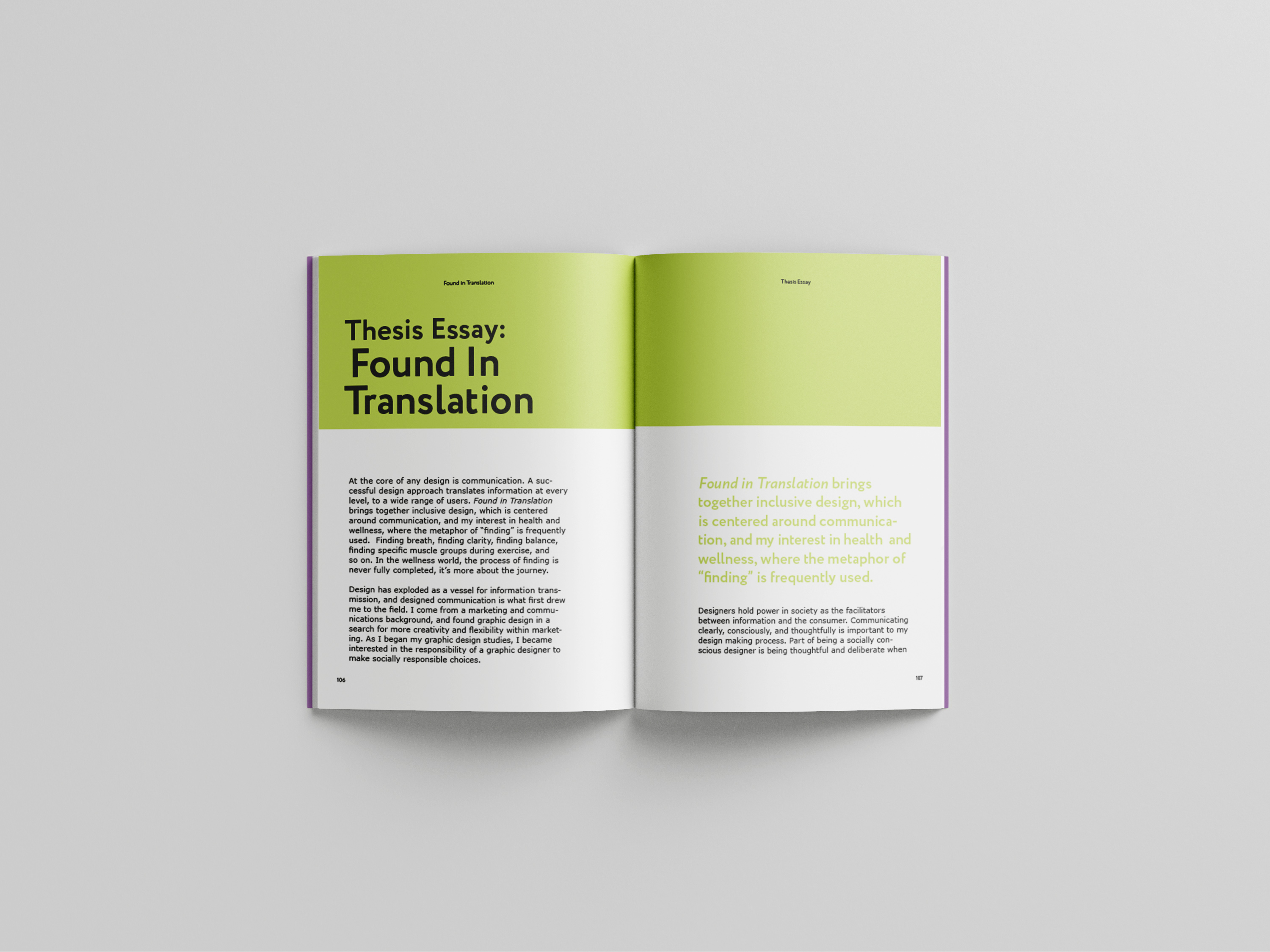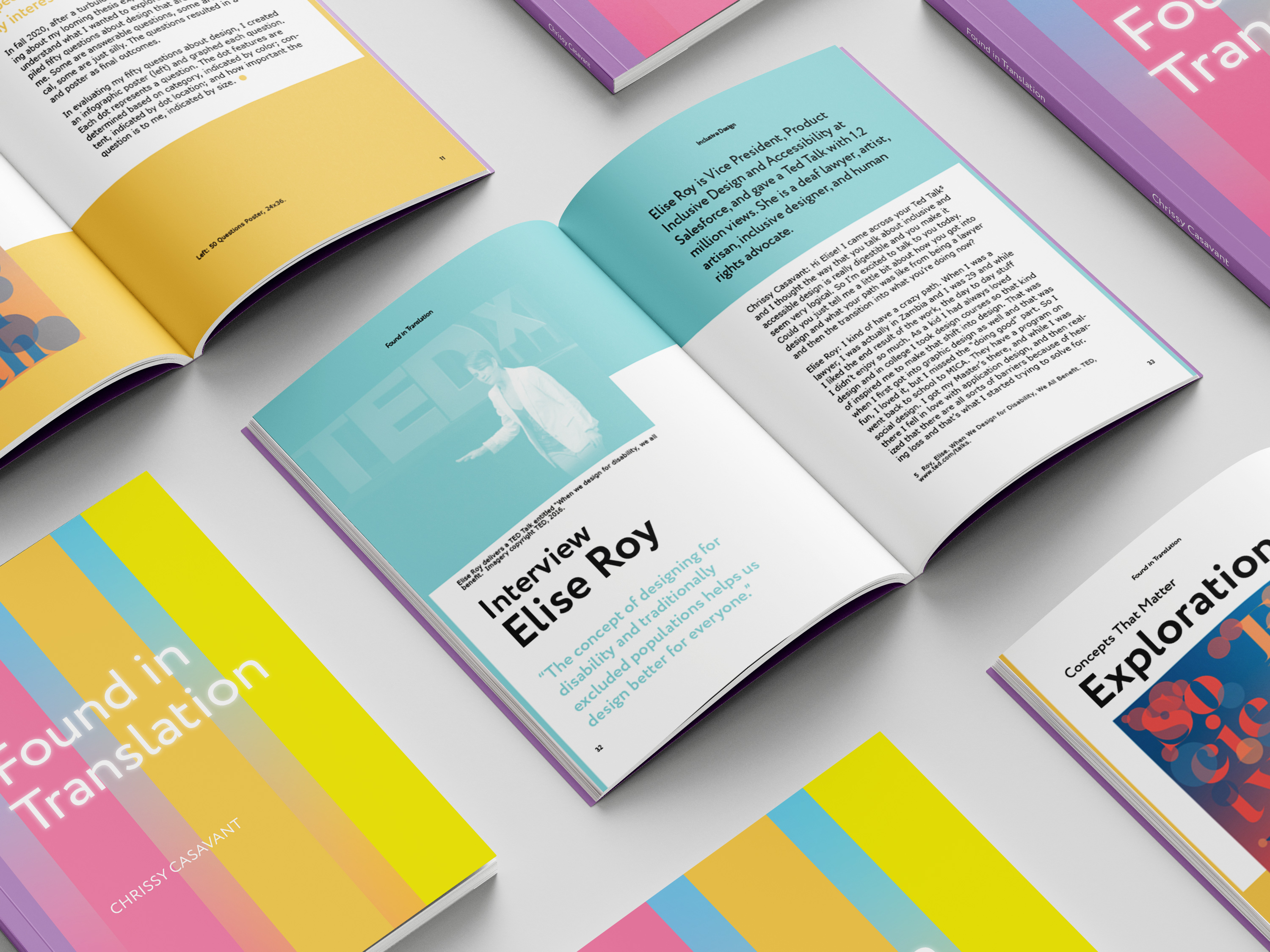At the core of any design is communication. A successful design approach translates information at every level, to a wide range of users. Found in Translation brings together inclusive design, which is centered around communication, and my interest in health and wellness, where the metaphor of “finding” is frequently used. Finding breath, finding clarity, finding balance, finding specific muscle groups during exercise, and so on. In the wellness world, the process of finding is never fully completed, it’s more about the journey.
Design has exploded as a vessel for information transmission, and designed communication is what first drew me to the field. I come from a marketing and communications background, and found graphic design in a search for more creativity and flexibility within marketing. As I began my graphic design studies, I became interested in the responsibility of a graphic designer to make socially responsible choices.
Designers hold power in society as the facilitators between information and the consumer. Communicating clearly, consciously, and thoughtfully is important to my design making process. Part of being a socially conscious designer is being thoughtful and deliberate when making choices about working with a client or making design decisions that can reach the greatest number of users, and that comes with designing inclusively.
In our digital era, and particularly in the pandemic world that exists as I write this essay, technology allows individuals to maintain a human connection while physical connection is on hold. More individuals are dependent on technology to connect with the world than ever before, and that brings both the challenge and beauty of inclusive design. When life as we knew it suddenly shifted to virtual reality, inclusive and accessible design became an essential part of society. Messages, text based or subliminal, are communicated in seconds through digital communication tools, and their design can help or hinder that communication.
Design has exploded as a vessel for information transmission, and designed communication is what first drew me to the field. I come from a marketing and communications background, and found graphic design in a search for more creativity and flexibility within marketing. As I began my graphic design studies, I became interested in the responsibility of a graphic designer to make socially responsible choices.
Designers hold power in society as the facilitators between information and the consumer. Communicating clearly, consciously, and thoughtfully is important to my design making process. Part of being a socially conscious designer is being thoughtful and deliberate when making choices about working with a client or making design decisions that can reach the greatest number of users, and that comes with designing inclusively.
In our digital era, and particularly in the pandemic world that exists as I write this essay, technology allows individuals to maintain a human connection while physical connection is on hold. More individuals are dependent on technology to connect with the world than ever before, and that brings both the challenge and beauty of inclusive design. When life as we knew it suddenly shifted to virtual reality, inclusive and accessible design became an essential part of society. Messages, text based or subliminal, are communicated in seconds through digital communication tools, and their design can help or hinder that communication.


Accessibility design is increasingly a requirement for designers, particularly in web and digital design. It was an easy place to start my research because the rules are very clear and very specific. In web design, designing for accessibility has little gray area. Print design has a little bit more flexibility, but the guidelines are still relatively strict. This book was designed according to print accessibility guidelines: including typeface choice, spacing, type size, and color choices. As I learned from my interviews and research, accessible design specifically considers the needs of users with disabilities. Unfortunately, much of accessible design is added to meet the bare minimum requirements. I came across inclusive design early in my research about accessibility, and universal design is also frequently referenced in these same resources as well.
Universal design is created specifically to reach the greatest number of people, including, but not specifically, those with disabilities. After my conversation with Elise Roy, she noted that universal design, in its quest to be used by everyone, often excludes those with disabilities. Universal design considers how to create a product that is easy and efficient to use for the average user.
Inclusive design then, is the larger umbrella design approach that both universal design and accessibility design fall into. Inclusive design expands access to information to a wide range of users, and carefully considers the user. It is reflective of the mental space a user may be in, physical location, and is inclusive of disability or challenges. And what intrigues me the most about inclusive design is that it’s new, it’s progressing, and there’s space for significantly more growth and creativity.
Universal design is created specifically to reach the greatest number of people, including, but not specifically, those with disabilities. After my conversation with Elise Roy, she noted that universal design, in its quest to be used by everyone, often excludes those with disabilities. Universal design considers how to create a product that is easy and efficient to use for the average user.
Inclusive design then, is the larger umbrella design approach that both universal design and accessibility design fall into. Inclusive design expands access to information to a wide range of users, and carefully considers the user. It is reflective of the mental space a user may be in, physical location, and is inclusive of disability or challenges. And what intrigues me the most about inclusive design is that it’s new, it’s progressing, and there’s space for significantly more growth and creativity.
Inclusive design can improve the quality of life and ease of access to information for a wide range of users, and create impactful social change. I’m interested in exploring both digital and physical inclusive design, as they each have capability to reach different audiences. Analog design has staying power, while digital design offers adaptability. Both are important for a designer like myself to understand.
Across my research, the use of the term “inclusive design” is encouraged as it “make(s) the case for design that anticipates the widest possible spectrum of people across the spectrum of ability, age, culture, and socioeconomic status.” As a designer, I inherently design for myself. I’m an able bodied, English speaking, millennial designer. I often don’t know what I don’t know, and what I may be missing from my work. It’s easy to accidentally sidestep inclusive design, but deliberately considering how to make my work more inclusive will allow me to reach the greatest number of users and make socially responsible formatting choices.
I’m particularly interested in using inclusive design in the context of health and wellness tools and organizations. I’m excited by and have personal interest in wellness and have enjoyed my work doing design in the healthcare industry. There’s a need for wellness design within the design community and in society as a whole. I personally struggle with prioritizing my wellness, and I’ve seen a lot of people close to me struggle with various types of wellness challenges. Inclusive design could help solve wellness issues in a time when stress and anxiety are at a high, and individuals are feeling isolated and scared.
Across my research, the use of the term “inclusive design” is encouraged as it “make(s) the case for design that anticipates the widest possible spectrum of people across the spectrum of ability, age, culture, and socioeconomic status.” As a designer, I inherently design for myself. I’m an able bodied, English speaking, millennial designer. I often don’t know what I don’t know, and what I may be missing from my work. It’s easy to accidentally sidestep inclusive design, but deliberately considering how to make my work more inclusive will allow me to reach the greatest number of users and make socially responsible formatting choices.
I’m particularly interested in using inclusive design in the context of health and wellness tools and organizations. I’m excited by and have personal interest in wellness and have enjoyed my work doing design in the healthcare industry. There’s a need for wellness design within the design community and in society as a whole. I personally struggle with prioritizing my wellness, and I’ve seen a lot of people close to me struggle with various types of wellness challenges. Inclusive design could help solve wellness issues in a time when stress and anxiety are at a high, and individuals are feeling isolated and scared.


Healthcare design and wellness design are both huge industries, and it’s important to acknowledge that they are industries that are financially driven in many ways. But I also really believe in the power that wellness design has, especially in a pandemic. I’m inspired by the history of wellness design, and the way wellness design has created an industry that is life changing for so many people, including myself, in a digital age. Similarly, healthcare design can make a massive difference in the lives of the public and of patients. Public service healthcare design spreads information clearly and concisely. Internal healthcare design can improve patient experience. Healthcare design is deeply rooted in inclusive design, as many healthcare facilities and communications are used by a range of people. Wellness design isn’t as inclusive as it should be, yet. I plan to continue research and contribute to inclusive wellness as a designer.
The research and assembly of this thesis work deepened my understanding of inclusive design and opened my eyes to areas that need more work, and to my own areas for growth. Making work more inclusive of users of varied age, ability, culture, and socioeconomic status benefits everyone: the client’s message gets distributed farther, the user can access information more, and the designer’s work is successfully communicated. Inclusive design, especially in health and wellness, can change lives for the better and improve human experience.
The research and assembly of this thesis work deepened my understanding of inclusive design and opened my eyes to areas that need more work, and to my own areas for growth. Making work more inclusive of users of varied age, ability, culture, and socioeconomic status benefits everyone: the client’s message gets distributed farther, the user can access information more, and the designer’s work is successfully communicated. Inclusive design, especially in health and wellness, can change lives for the better and improve human experience.